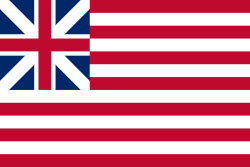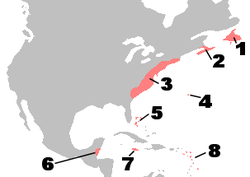Thirteen Colonies
The Thirteen Colonies were colonies in British North America in what is now the Eastern Seaboard of the United States. They were founded for different reasons. Some people thought that they would make a lot of money in new goods in America that could not be found in Europe, such as tobacco. Others left to find freedom of religion or just to make a new start. Some wanted to be in charge and to change things that they did not like back at England.
Thirteen Colonies | |||||||||||
|---|---|---|---|---|---|---|---|---|---|---|---|
| 1607–1776 | |||||||||||
| Anthem: | |||||||||||
 The Thirteen Colonies (shown in red) in 1775 with modern borders overlaid | |||||||||||
| Status | Colonies | ||||||||||
| Government | Various colonial arrangements | ||||||||||
| Monarch | |||||||||||
• 1607–1625 | James I & VI (first) | ||||||||||
• 1760–1776 | George III (last) | ||||||||||
| History | |||||||||||
| 1585 | |||||||||||
• | 1607 | ||||||||||
| 1620 | |||||||||||
| 1663 | |||||||||||
• New Netherland ceded to England | 1667 | ||||||||||
| 1713 | |||||||||||
| 1732 | |||||||||||
| 1754–1763 | |||||||||||
| 1774 | |||||||||||
| 1776 | |||||||||||
• | 1783 | ||||||||||
| Population | |||||||||||
• 1625 | 1,980[1] | ||||||||||
• 1775 | 2,400,000 | ||||||||||
| |||||||||||
| Today part of | United States | ||||||||||
The first colony was Virginia, which was started in 1607 at Jamestown. The last colony of the thirteen to be started was Georgia in 1732.
The Thirteen Colonies (listed from north to south):
- New Hampshire
- Massachusetts
- Rhode Island
- Connecticut Colony
- New York
- New Jersey
- Pennsylvania
- Delaware
- Maryland
- Virginia Colony
- North Carolina
- South Carolina
- Georgia
The colonies are often divided into three groups. The northern group was called New England and included New Hampshire, Massachusetts, Rhode Island, and Connecticut.
There were four Middle Colonies: New York, New Jersey, Pennsylvania, and Delaware.
The South had five colonies: Maryland, Virginia, North Carolina, South Carolina, and Georgia.
New England had small farms and focused on fishing, forestry (trees and lumber), shipping, and small industry to make money.[2]
The South had large plantation farms that grew tobacco and later cotton. Plantations were farmed first by indentured servants, who would work for a period of years in return for their passage to America and land. They were later replaced by slaves.
The Middle Colonies had medium-sized farms. They also had people from many different cultures with many different beliefs.[3]
All three regions were tied to the "Atlantic economy". Colonists built merchant vessels, and merchants traded slaves, agricultural goods, gold, fish, lumber, and manufactured goods between America, the West Indies, Europe and Africa.[4]
After the French and Indian War, Great Britain made new taxes and other laws that angered some people in the colonies. That led to a war between Great Britain and its former colonies: the American Revolutionary War.
The colonies said why they wanted to become independent of Great Britain on July 4, 1776 at the Declaration of Independence and became known as the United States of America.
Thirteen Colonies Media
Instrumental music without lyrics: Rufst du, mein Vaterland also known as God Save the King, Íslands minni, Kongesangen and Oben am jungen Rhein (1938)
The Thirteen Colonies of British America: (dark red): New England Colonies (red-brown): Middle Colonies (brown): Southern Colonies
The 1606 grants by James I to the London and Plymouth companies. The overlapping area (in yellow) was granted to both companies on the stipulation that neither found a settlement within 100 miles (160 km) of each other. The location of early settlements is shown, including Jamestown (J), Quebec (Q), Popham (Po), Port Royal (R), and St. Augustine (SA).
Territorial changes following the French and Indian War; land held by the British before 1763 is shown in red and land gained by Britain in 1763 is shown in pink
Join, or Die by Benjamin Franklin was recycled to encourage the former colonies to unite against British rule.
A map of the Thirteen Colonies (in red) and nearby colonial areas (1763–1775) just before the Revolutionary War
- Some of the British colonies in North America, c. 1750
- Newfoundland
- Nova Scotia
- Thirteen Colonies
- Bermuda
- Bahamas
- British Honduras
- Jamaica
- British Leeward Islands and Barbados
References
- ↑ U.S. Census, 1906, p. 9
- ↑ Morison, Samuel Eliot (1972). The Oxford History of the American People. New York City: Mentor. pp. 199–200. ISBN 0451-62600-1.
- ↑ Kennedy, David; Lizabeth Cohen and Thomas A. Bailey (2006). The American Pageant (13th ed.). Boston: Houghton Mifflin. ISBN 0618479406.
- ↑ Kurlansky, Mark (1997). Cod: A Biography of the Fish That Changed the World. New York: Walker. ISBN 0-8027-1326-2.









